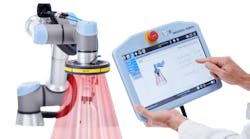In many applications, the need for a sensor is evident. Detecting a registration mark on a continuous web is usually a must to synchronize the material for cutting or printing, for example. The end user may drive the need for sensors by requiring one at the end of travel of every cylinder or actuator motion. But does it help to sense every position, or can it cause more downtime and problems than it is worth? And, on top of that, do the parts always need to be sensed, or can the program logic assume the part is there?
A discussion of part presence cannot be complete without including cylinder or actuator position sensing. In most cases, position sensors on cylinders and actuators are considered a best practice for automated equipment. The position sensors provide real feedback for use in the program logic, incrementing the sequence only a cylinder reaches a position.
Detecting that an actuator has come to an end position doesn't mean it's OK to use position sensors as hard stops. The sensors need to be designed into the system to detect position accurately. Careful installation of the sensor, whether mounted on an actuator or sensing tooling, is critical as improper sensor installation can be worse than no sensor at all.
The alternative to position sensors is to use timers that, when done, the program logic assumes the cylinder has reached a position. Timers are a poor choice, and a program that uses them is just "hopeful logic." Hoping that the air pressure is OK, the flow control hasn't changed and the cylinder is moving at a consistent speed is not a robust automation plan. A lazy cylinder can cause problems. This timer-based method can also slow down the machine while waiting for timers to time out.
Some programmers will write a complete step sequence using timers' done bits to increment an automatic sequence. However, in most cases, elimination of position sensors is a bad design decision unless it is a short travel distance of less than an inch.
An example of a short travel sensing application is detecting gripper position. Often, a gripper may be small, hard to access and difficult to adjust to detect its open and closed position. In these cases, it may be better to write the machine program to assume the position of the gripper based on a timer value. The short stroke distance and quick operation of a gripper are often consistent enough to eliminate an open and closed position sensor yet improve machine robustness and reliability.
A position sensor can sometimes act as a part-in-position-and-seated-properly sensor by detecting over-travel or under-travel of a cylinder. In these cases, the position sensor can be used to detect the presence of an incorrectly presented or an improperly located part. For example, in a press application, a cylinder under-travel condition, not reaching an end-of-travel sensor, could indicate a jammed part or an upside-down part. Cylinder over-travel could mean a missing part or an improperly positioned part. In this example, designing a press and specifying sensors that can detect under-travel and that can reach and detect over-travel conditions should be considered. The failure modes of part assembly would need to be carefully examined to specify these under-travel and over-travel conditions.
ALSO READ: See what’s new with photoelectric sensors
Error-proofing and quality
The bottom line for the use of presence and position sensors is the need for error-proofing and improving quality. Logic decisions based on actual position, not time delays, and detection of the part presence, not assuming it is there, make better parts faster. Sensors improve final product quality. All parts are present because they are sensed, and assembly is complete because full press depth was reached. These are just some of the quality checks sensors provide.
The lack of sensors may save money, installation time and programming, but how do you know you are making a good part or a proper assembly with all the parts present? You need to sense it. And while you are at it, you need to detect a good part was offloaded and the nest it was removed from is empty before another part is inserted. If you are still struggling with whether you need that good-part-present sensor, be sure to add a reject-part-offloaded sensor to make sure failed components are accurately controlled and removed from the system by detecting they dropped into a reject bin.
To add or not add a sensor is the question. Normally, adding a sensor is the best choice, although eliminating a few may help in some cases. When in doubt, add a sensor. It's often the best option to error-proof the machine to make better quality parts.
Dave Perkon is technical editor for Control Design. He has engineered and managed automation projects for Fortune 500 companies in the medical, automotive, semiconductor, defense and solar industries.






